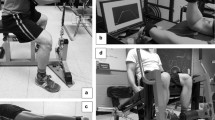Abstract
The purpose of this paper is to present a case study of a patient with a history of low back pain and the use of isokinetic testing in tracking that patient through a work-reentry program. A 44-year-old male with a diagnosis of low back pain underwent a functional capacity evaluation and began a work-reentry program. Initial isokinetic testing revealed low torque outputs in both the trunk and knee flexion and extension tests as well as limited active range of motion. Coefficient of variation appeared to be relatively high and the patient seemed guarded in his movements during the testing. Psychological testing revealed a high fear of reinjury which may have influenced the initial test. Subsequent isokinetic testing performed on the tenth and twenty-fourth days of program and at 1 month post-program exhibited greater than expected increases in torque output. This could be due in part to a reduction in the fear of reinjury, a learning effect with repeated exposure to testing, and the patient's increased confidence in the use of unguarded movements. His trunk range of motion remained essentially the same throughout the serial testing. Pain in the back and left leg was slightly diminished despite an increase in strength and function.
Similar content being viewed by others
References
Perrin DH, Reliability of isokinetic measures.Athletic Training 1986; 21: 319–321.
Nachemson A, Lindh M. Measurement of abdominal and back strength with and without low back pain.Scand J Rehab Med 1969; 1: 60–65.
Deyo RA. Conservative therapy for low back pain: Distinguishing useful from useless therapy.JAMA 1983; 250: 1057–1062.
MacDougall JD, Wenger HA. The purpose of physiological testing. In MacDougall JD, Wenger HA, Green HJ, eds,Physiological testing of the elite athlete. Ithaca, NY: Movement Publications, 1983; 1–2.
Astrand PO, Rodahl K.Textbook of work physiology: Physiological bases of exercise. New York: McGraw Hill Book Co, 1986.
Department of Labor:Dictionary of occupational titles (4th Ed.), Washington, D.C.: U.S. Department of Labor, 1977.
Loredan Biomedical.Lido isokinetic rehabilitation system operators manual. Davis, CA: Loredan Biomedical, 1988.
Mayer TG, Gatchel RJ.Functional restoration for spinal disorders: The sports medicine approach. Philadelphia: Lea and Febiger, 1988.
Muller EA. Influence of training and of inactivity on muscle strength.Arch PMR 1970; 51: 449–462.
Smith LE. Strength increments following massed and distributed practice relative to motor learning.Med Sci Sports Exercise 1974; 6: 154–157.
Author information
Authors and Affiliations
Rights and permissions
About this article
Cite this article
Hickey, P.F. Isokinetic strength testing in monitoring progress in a multidisciplinary work reentry program: A case study. J Occup Rehab 1, 83–90 (1991). https://doi.org/10.1007/BF01073282
Issue Date:
DOI: https://doi.org/10.1007/BF01073282




